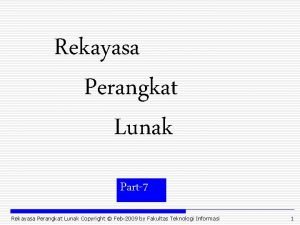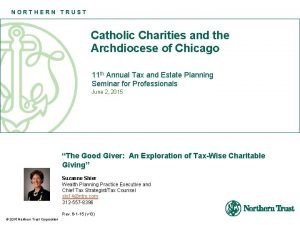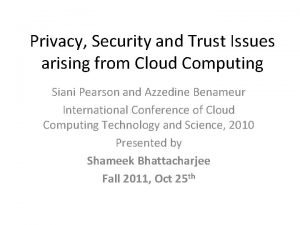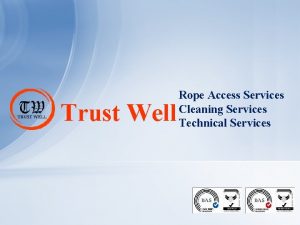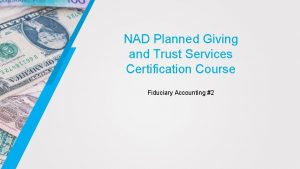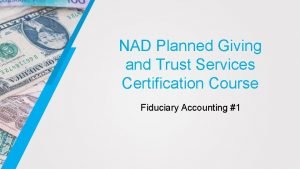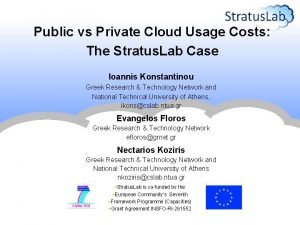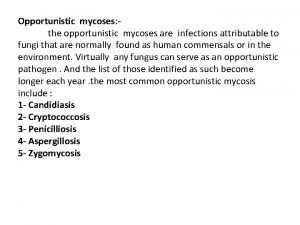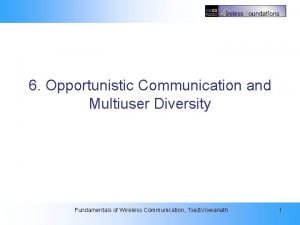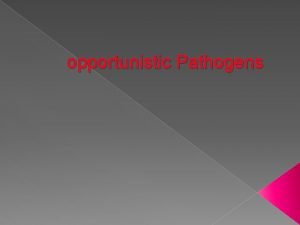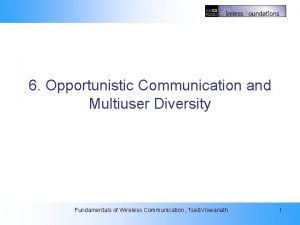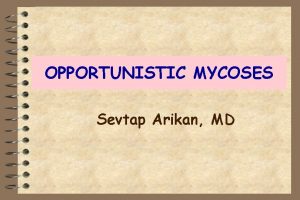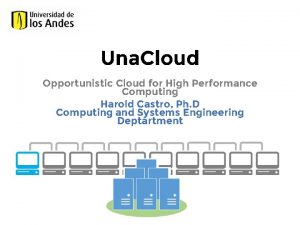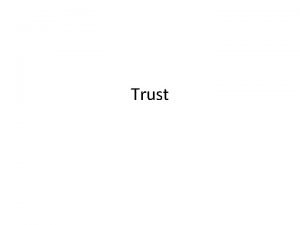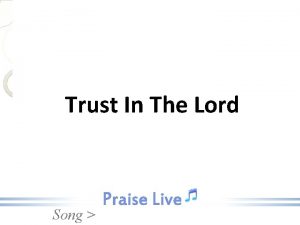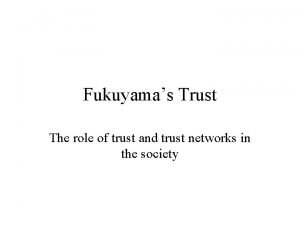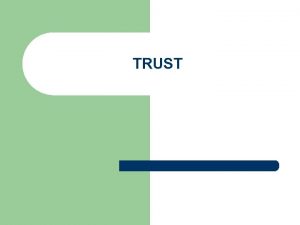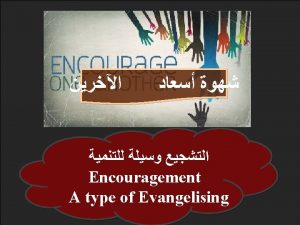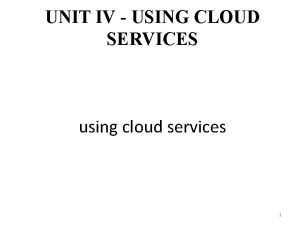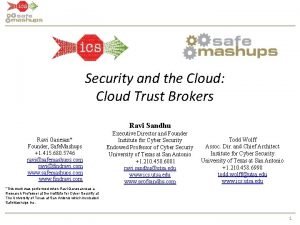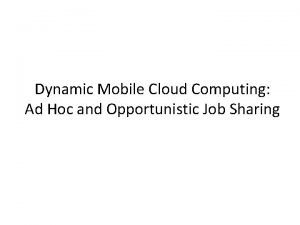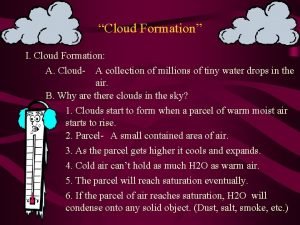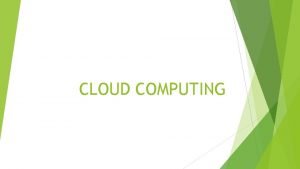Trust Management System for Opportunistic Cloud Services kuadacmi









































- Slides: 41

Trust Management System for Opportunistic Cloud Services kuada@cmi. aau. dk Eric Kuada(lecturer/Ph. D Fellow)

Presentation Outline Introduction THIS IS A DARKBLUE CIRCLE WITH TEXT § Background § Motivation for the Study § Trust Engineering in Cloud Computing Overview of Opportunistic Cloud Services Trust Model for OCS Platforms § Nature of Members and Services § Trust Model in the context of OCS Trust Management System & Architecture Trust Model Verification conclusion Department of Electronic Systems AALBORG University Copenhagen

INTRODUCTION Background Part of papers from Ph. D study q. E. Kuada and H. Olesen, “A Social Network Approach to Provisioning and Management of Cloud Computing Services for Enterprises, ” presented at the CLOUD COMPUTING 2011, The Second International Conference on Cloud Computing, GRIDs, and Virtualization, 2011, pp. 98– 104. q. E. Kuada and H. Olesen, “Incentive mechanisms for Opportunistic Cloud Computing Services, ” in 2012 8 th International Conference on Collaborative Computing: Networking, Applications and Worksharing (Collaborate. Com), 2012, pp. 127 – 136. q. E. Kuada, H. Olesen, and A. Henten, “Public Policy and Regulatory Implications for the Implementation of Opportunistic Cloud Computing Services for Enterprises, ” in Workshop on Security in Information Systems, Wroclav, 2012. q. E. Kuada, K. Adanu, and H. Olesen, “Cloud Computing and Information Technology Resource Cost Management for SMEs, ” in Proceedings of IEEE Region 8 Conference Euro. Con 2013, University of Zagreb, Croatia, 2013, pp. 258 – 265. Department of Electronic Systems AALBORG University Copenhagen

Motivation for the Study q Spare IT Resources at Enterprises and other Organisations q SMEs and even larger Enterprises and organisations need IT resources q It have been difficult or even impossible to make spare IT resources available to those who need them q Advent of Cloud Computing should make this less difficult q Free Cloud Services Patronage q A need for a platform that supports opportunistic provisioning and utilization of cloud resources Department of Electronic Systems AALBORG University Copenhagen

Opportunistic Cloud Services Leveraging cloud technologies by enterprises to provide and utilize cloud services among themselves without entering into any business agreements It is modeled as a social network of members strategically contributing and utilizing Cloud resources Department of Electronic Systems AALBORG University Copenhagen

Nature of Members and Services An OCS network consists of a set of strategic members contributing and utilizing cloud services. The platform consists of a set of services each belonging to a category Each service has a non-monetary cost that varies dynamically. The service or resource contributed by a member is of a certain finite capacity and the resources to a particular service may be contributed by multiple members. Members will normally only contribute resources that they have spare capacity of, i. e. they package their spare IT resources as Cloud services and make them available to the OCS platform. Members are free to provide and discontinue one or more services at will at any point in time. They are likewise free to use or discontinue the usage of one or more services at will at any point in time Department of Electronic Systems AALBORG University Copenhagen

OCS Trust Problem Trust and security problems in cloud computing are enhanced in opportunistic cloud services Need to design and develop a trust management system for OCS Department of Electronic Systems AALBORG University Copenhagen

Trust Engineering in Cloud Computing Resutls from systematic review of trust engineering in cloud computing a. b. c. d. Employing trusted computing technologies Reputation based approaches Trusted third party approaches The deployment model also play a significant part in enhancing trust between service providers and their consumers Department of Electronic Systems AALBORG University Copenhagen

Trust Model for OCS Platforms The subjective nature of the concept of trust has made a solid definition elusive. Researchers have most often used the term loosely in their work A rigorous formal definition has not been applied in most cases Formal definition or specification of the concept of trust is however needed for ensuring a unified view of the concept of trust in the design and engineering of trust management systems Department of Electronic Systems AALBORG University Copenhagen

Trust Model for OCS Platforms (cont. ) Level of trust of a service provider for a service consumer Department of Electronic Systems AALBORG University Copenhagen

Trust Model for OCS Platforms (cont. ) Since a particular service may come into fruition as a combination of resources and services from multiple providers, each service’s trust level must be assessed as an autonomous entity even though this trust level is a function of the composite trust level o f t h e p r o v i d e r s a n d t h e b a s e r v i c e s f r o m w h i c h i t h a s b e e n d e r i v e d. Department of Electronic Systems AALBORG University Copenhagen

Systematic Review Results Trust Production Approaches Norms and institutional guarantees attempt to reduce the uncertainty on the behavior of other agents by prescribing specific allowed behavioral ranges Indirect cues are attributes of an agent, which we have associated with certain likely behaviors based on our experience, intuition and training. Reputational information is information about, or observations of an agent’s past behavior on similar situations Employing trusted computing technologies and reputation based approaches Trusted third party approaches and the deployment model play a significant part in enhancing trust between service providers and their consumers. Department of Electronic Systems AALBORG University Copenhagen

Systematic Review Results (cont. ) Trusted third party based and the reputation based approaches comes handy in the context of trust engineering for OCS environments.

OCS Trust Management System & Architecture Department of Electronic Systems AALBORG University Copenhagen

EXPECTATION MANAGER The expectation manager is responsible for handling the creation and maintenance of the OCS Platform pseudo SLA (p. SLA) templates, the service provider assignment of services to a particular p. SLA template, and the creation of service SLA (s. SLA) to meet the specification of each service. Department of Electronic Systems AALBORG University Copenhagen

STEP 1 Department of Electronic Systems AALBORG University Copenhagen

STEP 2 Department of Electronic Systems AALBORG University Copenhagen

STEP 3 Department of Electronic Systems AALBORG University Copenhagen

STEP 4 Department of Electronic Systems AALBORG University Copenhagen

STEP 5 Department of Electronic Systems AALBORG University Copenhagen

STEP 6 Department of Electronic Systems AALBORG University Copenhagen

STEP 7 Department of Electronic Systems AALBORG University Copenhagen

STEP 8 Department of Electronic Systems AALBORG University Copenhagen

STEP 9 Department of Electronic Systems AALBORG University Copenhagen

STEP 10 Department of Electronic Systems AALBORG University Copenhagen

OCS Trust Management Architecture DMo. M & DMa. M The DMo. M is responsible for defining new trust data that needs to be monitored on the OCS platform in order to accommodate for adapting the platform to future needs such as when new service and trust value categories are needed to be computed The DMa. M is responsible for defining data storage policies such as for example local storage of trust matrix by members, storage of member interactions by the OCS platform, the types of communication and data to be exchanged. It also deals with data reliability, security, recovery in case of problems, and maintaining consistency in situations of discrepancies in data from multiple sources Department of Electronic Systems AALBORG University Copenhagen

OCS Trust Management Architecture (cont. ) TAM Department of Electronic Systems AALBORG University Copenhagen

Trust Values Computation Algorithm (cont. ) Department of Electronic Systems AALBORG University Copenhagen

Trust Model Verification Table 1: p. SLA template for Iaa. S Table 2: s. SLA created from a p. SLA Attribute value types Attributes value types Service Identification Service ID & category ID Service Type / category Iaa. S & category ID Availability 50 % uptime Availability 95 % uptime Service support No Service support type N/A Maintenance notification Yes SLA dependencies {} Service location {} Security None Security Data backup & recovery Data encryption None Privacy None Certification {} Department of Electronic Systems AALBORG University Copenhagen

COMPUTATION OF TRUST VALUES Department of Electronic Systems AALBORG University Copenhagen

Composite trust level with varying service weight, where the trustworthiness of the service approximates a uniform distribution, and the trustworthiness of the provider approximates a normal distribution with the same standard deviation as that of the uniform distribution Department of Electronic Systems AALBORG University Copenhagen

Trust level against varying user utility when the service and the service provider have equal weight of 0. 5 in the composite trust value Trust level against varying user utility when the service has a weight of 1 Department of Electronic Systems AALBORG University Copenhagen

Trust level against varying user utility when the provider has a weight of 1 Department of Electronic Systems AALBORG University Copenhagen

OCS Trust Management Architecture (cont. ) DSM The decision support manager is responsible for taking results from the trust value computations of the analysis manager and presenting it in a format that simplify visualization for the users. The user-friendly trust value representation together with making recommendations on decisions to be taken by users should facilitate their decision making process. Department of Electronic Systems AALBORG University Copenhagen

OCS Trust Management Architecture (cont. ) PGEM This module is responsible for ensuring good and acceptable behavior on the platform. It applies appropriate sanctions to undesirable behaviors on the platform. It is therefore responsible for malicious conditions detection and the detection of SLA violation, and then taking appropriate remedial actions such as removing offending services from the platform and banning offending users Department of Electronic Systems AALBORG University Copenhagen

Conclusion q A model for the concept of trust for cloud computing environments q Designed a trust management system for Opportunistic Cloud Services q Pseudo SLA systme for Opportunistic Cloud Services q Verified the trust model and the trust management system through the simulation of the computation of the trust values with Iaa. S, and Saa. S examples. q Even though our trust management systems contain the complete elements, I have focused mainly of the modeling of the concept of trust for the OCS platforms and the trust analysis components in the architecture. q The other aspects require further work in terms of the implementation of the data monitoring and data management components. q Secondly the decision support system and usability of the pseudo SLA templates in the system needs some further work for their verification. q These further works will also require verifying the robustness and scalability of the trust management system. Department of Electronic Systems AALBORG University Copenhagen

Thanks Department of Electronic Systems AALBORG University Copenhagen

Extra Slides Department of Electronic Systems AALBORG University Copenhagen

Table 3: p. SLA for Saa. S Attribute value types Service Identification Service ID &category ID Service Type / category Saa. S & category ID Availability 50 % uptime Service support No Service support type N/A Maintenance notification Yes SLA dependencies {} Service location {} Security None Data encryption None Privacy None Certification {} Performance (Throughput) 1 Kbps Performance(Response time) 5 sec Department of Electronic Systems AALBORG University Copenhagen

Trust Production Approaches & Systemat ic Review Results Norms and institutional guarantees attempt to reduce the uncertainty on the behavior of other agents by prescribing specific allowed behavioral ranges (which usually correspond to satisfactory outcomes for the majority of transaction types and society members) and by providing institutions, which prevent deviations or make such deviations highly unlikely because of quick detection and effective sanctions Indirect cues are attributes of an agent, which we have associated with certain likely behaviors based on our experience, intuition and training. Reputational information is information about, or observations of an agent’s past behavior on similar situations that is aggregated and distributed by means of word-ofmouth or through trusted third parties, such as credit rating agencies, consumer reports, etc. Employing trusted computing technologies and reputation based approaches are two key approaches to trust engineering in the cloud computing marketplace. Also trusted third party approaches and the deployment model play a significant part in enhancing trust between service providers and their consumers. Trusted third party based and the reputation based approaches comes handy in the context of trust engineering for OCS environments.

PARAMETERS OF REPUTATIONAL RATINGS The reputational ratings are based on the intent, integrity, capability and results Intent constitutes information about declared agendas about what entities promise to provide through their services. Integrity constitutes information about honesty; this is a measure of, to what extent entities deliver on what they promised. Capability constitutes information about owned resources (what assets parties have) Results constitute information about products and services that entities specialized in through consistently delivering these products and services satisfactorily to their clients
 Opportunistic infections
Opportunistic infections Opportunistic infections
Opportunistic infections Opportunistic approach adalah model proses
Opportunistic approach adalah model proses Nation and macalister 2010
Nation and macalister 2010 Retroviruses and opportunistic infections
Retroviruses and opportunistic infections Northern trust charitable trust
Northern trust charitable trust Azzedine benameur
Azzedine benameur Fidelity personal trust company
Fidelity personal trust company Trustwell
Trustwell Planned giving and trust services
Planned giving and trust services Planned giving and trust services
Planned giving and trust services Cloud computing refers to
Cloud computing refers to Cloud integration patterns
Cloud integration patterns Public cloud vs private cloud cost analysis
Public cloud vs private cloud cost analysis Snap cloud
Snap cloud Formuö
Formuö Typiska drag för en novell
Typiska drag för en novell Nationell inriktning för artificiell intelligens
Nationell inriktning för artificiell intelligens Returpilarna
Returpilarna Varför kallas perioden 1918-1939 för mellankrigstiden?
Varför kallas perioden 1918-1939 för mellankrigstiden? En lathund för arbete med kontinuitetshantering
En lathund för arbete med kontinuitetshantering Underlag för särskild löneskatt på pensionskostnader
Underlag för särskild löneskatt på pensionskostnader Personlig tidbok
Personlig tidbok Sura för anatom
Sura för anatom Densitet vatten
Densitet vatten Datorkunskap för nybörjare
Datorkunskap för nybörjare Boverket ka
Boverket ka Debatt artikel mall
Debatt artikel mall Delegerande ledarskap
Delegerande ledarskap Nyckelkompetenser för livslångt lärande
Nyckelkompetenser för livslångt lärande Påbyggnader för flakfordon
Påbyggnader för flakfordon Formel för lufttryck
Formel för lufttryck Publik sektor
Publik sektor Jag har gått inunder stjärnor text
Jag har gått inunder stjärnor text Presentera för publik crossboss
Presentera för publik crossboss Argument för teckenspråk som minoritetsspråk
Argument för teckenspråk som minoritetsspråk Kanaans land
Kanaans land Klassificeringsstruktur för kommunala verksamheter
Klassificeringsstruktur för kommunala verksamheter Fimbrietratt
Fimbrietratt Claes martinsson
Claes martinsson Centrum för kunskap och säkerhet
Centrum för kunskap och säkerhet Verifikationsplan
Verifikationsplan


